Lea Wait's Blog, page 89
May 15, 2022
Feel-Good Movies
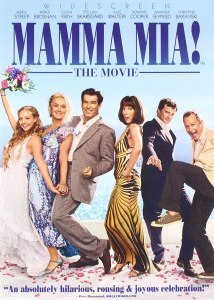 Kaitlyn Dunnett/Kathy Lynn Emerson here. Seen any good movies lately?
Kaitlyn Dunnett/Kathy Lynn Emerson here. Seen any good movies lately?
I don’t necessarily mean at a movie theater. The last time I went to a new-release film in person (and in a crowd) was back when Mamma Mia! (the first one) came out, and I only went to see that one because the old friend I wanted to reconnect with in the Nashville TN area, where I was attending a conference, had already bought a ticket for that particular showing and didn’t want to miss it. It turned out to be a great way to spend part of an evening. Since then, the film has become one of my go-to rewatches when I want to put myself in a happy frame of mind.
As you’ve probably deduced, I prefer to watch movies in the comfort of my own home, and almost every evening during the last couple of years, I’ve either streamed a movie or binge-watched a few episodes of a TV series on my iPad. I have a huge collection of DVDs (and a few old VHS tapes of material not available on DVD) and I rewatch quite a few of them, too. There are several I’ll even watch when they turn up on network TV, despite the umpty-zillion commercial interruptions. Any time I need to cheer myself up, I have a long list of films to choose from.
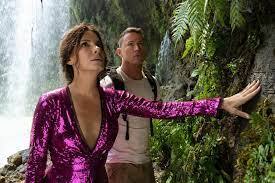 I’ve just added one more. Last week I streamed The Lost City, one of two movies I’ve had on my “buy” list ever since I first heard the plot lines. (The other is Jurassic World: Domination, which isn’t yet available.) This one is about a romance writer and her “real-life” adventure seeking treasure in a South American jungle. Based on that description, you might think, as some reviews have suggested, that it’s just an updated version of Romancing the Stone, but that’s not the case. For one thing, in my opinion, The Lost City isn’t a so much a romance as it is a screwball comedy. Romancing the Stone, another of my favorites, is a romance. It’s also, according to Christopher Vogler’s The Writer’s Journey (1995), a perfect example of “the hero’s journey.”
I’ve just added one more. Last week I streamed The Lost City, one of two movies I’ve had on my “buy” list ever since I first heard the plot lines. (The other is Jurassic World: Domination, which isn’t yet available.) This one is about a romance writer and her “real-life” adventure seeking treasure in a South American jungle. Based on that description, you might think, as some reviews have suggested, that it’s just an updated version of Romancing the Stone, but that’s not the case. For one thing, in my opinion, The Lost City isn’t a so much a romance as it is a screwball comedy. Romancing the Stone, another of my favorites, is a romance. It’s also, according to Christopher Vogler’s The Writer’s Journey (1995), a perfect example of “the hero’s journey.”
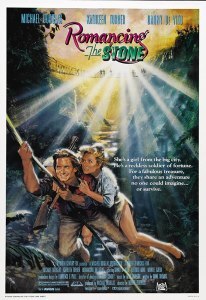 But I digress. And I’m about to digress again—I can’t help myself—to mention that one thing both movies do have in common is a strange idea of what the real romance publishing industry is like. Based on details in The Lost City, Loretta, Sandra Bullock’s character, is published by a small press in California. Most romance novels are published by large New York or Toronto houses. The writer would normally be badgered about her overdue manuscript by her agent, or possibly her editor (or the editor’s assistant), but not by her publisher, nor would the publisher be directly involved in promotion, let alone in tracking down her kidnapped writer when the police fail to act. Also, judging by details in the movie, our heroine doesn’t really write romance novels. She writes a romantic suspense/adventure series consisting of twenty books (yes, twenty!) featuring the same couple, Dr. Lovemore, an archaeologist, and her lover, Dash. Although Joan Wilder’s Angelina and Jessie apparently appeared in more than one Western historical romance in Romancing the Stone, “series” in the romance genre usually means several connected titles. A couple from one novel may appear in subsequent novels, but they are unlikely to be the hero and heroine of more than one book. These series are considered long-running if they reach seven entries.
But I digress. And I’m about to digress again—I can’t help myself—to mention that one thing both movies do have in common is a strange idea of what the real romance publishing industry is like. Based on details in The Lost City, Loretta, Sandra Bullock’s character, is published by a small press in California. Most romance novels are published by large New York or Toronto houses. The writer would normally be badgered about her overdue manuscript by her agent, or possibly her editor (or the editor’s assistant), but not by her publisher, nor would the publisher be directly involved in promotion, let alone in tracking down her kidnapped writer when the police fail to act. Also, judging by details in the movie, our heroine doesn’t really write romance novels. She writes a romantic suspense/adventure series consisting of twenty books (yes, twenty!) featuring the same couple, Dr. Lovemore, an archaeologist, and her lover, Dash. Although Joan Wilder’s Angelina and Jessie apparently appeared in more than one Western historical romance in Romancing the Stone, “series” in the romance genre usually means several connected titles. A couple from one novel may appear in subsequent novels, but they are unlikely to be the hero and heroine of more than one book. These series are considered long-running if they reach seven entries.
The whole cover-model aspect of The Lost City is (I hope) played for laughs. No author I’ve ever heard of has chosen her own cover model unless she was self-publishing, and although there used to be cover model events at Romantic Times conventions, having Loretta’s cover model appear on stage with her at a “Romance Faire” and completely take over the interview is definitely over the top. On the other hand, anyone who remembers a real-life cover model named Fabio, will find that scene hilarious.
Having said all that, you might conclude I didn’t like The Lost City. Reader, I loved it. It’s laugh-out-loud funny in multiple places, and the heroine, whose career as a writer is at a crisis point, has a great one-liner when she is faced with having to climb a cliff to escape from the villain. Contending that she doesn’t have the skill set to handle the challenge, she quips: “My skill is sitting and thinking and eating when I can’t think.” I can relate to that!
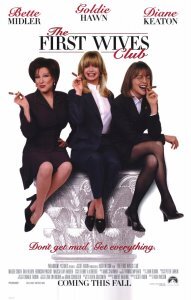 Not all the feel-good movies on my list have completely happy endings, and the titles change from time to time, but here, in no particular order, are some I’ve watched again in 2022, some more than once: First Wives Club; Sleepless in Seattle; Jurassic World; The Avengers; Independence Day; Grease; Fool’s Gold, Oceans 11; Oceans 8, Burlesque, Indiana Jones and the Kingdom of the Crystal Skull; The Avengers—Infinity War and Endgame (watched back to back, because Infinity War by itself is too depressing!); Mamma Mia 2: Here We Go Again (although the continuity errors between it and Mamma Mia! drive me crazy); Tremors; Serenity. There are also two I regularly watch at specific times of the year: Die Hard for Christmas and, as each year’s World Series approaches, especially if the Red Sox once again seem bent on seizing defeat from the jaws of victory, Fever Pitch.
Not all the feel-good movies on my list have completely happy endings, and the titles change from time to time, but here, in no particular order, are some I’ve watched again in 2022, some more than once: First Wives Club; Sleepless in Seattle; Jurassic World; The Avengers; Independence Day; Grease; Fool’s Gold, Oceans 11; Oceans 8, Burlesque, Indiana Jones and the Kingdom of the Crystal Skull; The Avengers—Infinity War and Endgame (watched back to back, because Infinity War by itself is too depressing!); Mamma Mia 2: Here We Go Again (although the continuity errors between it and Mamma Mia! drive me crazy); Tremors; Serenity. There are also two I regularly watch at specific times of the year: Die Hard for Christmas and, as each year’s World Series approaches, especially if the Red Sox once again seem bent on seizing defeat from the jaws of victory, Fever Pitch.
What movies do you watch when you want to lift your spirits?

Kathy Lynn Emerson/Kaitlyn Dunnett has had sixty-four books traditionally published and has self published others, including several children’s books. She won the Agatha Award and was an Anthony and Macavity finalist for best mystery nonfiction of 2008 for How to Write Killer Historical Mysteries and was an Agatha Award finalist in 2015 in the best mystery short story category. She was the Malice Domestic Guest of Honor in 2014. Her most recent publications are The Valentine Veilleux Mysteries (a collection of three short stories and a novella, written as Kaitlyn) and I Kill People for a Living: A Collection of Essays by a Writer of Cozy Mysteries (written as Kathy). She maintains websites at www.KaitlynDunnett.com and www.KathyLynnEmerson.com. A third, at A Who’s Who of Tudor Women, is the gateway to over 2300 mini-biographies of sixteenth-century Englishwomen.
May 13, 2022
Weekend Update: May 14-15, 2022
 Next week at Maine Crime Writers there will be a posts by Kaitlyn Dunnett/Kathy Lynn Emerson (Monday) Vaughn Hardacker (Tuesday), Charlene D’Avanzo (Thursday) and Kate Flora (Friday).
Next week at Maine Crime Writers there will be a posts by Kaitlyn Dunnett/Kathy Lynn Emerson (Monday) Vaughn Hardacker (Tuesday), Charlene D’Avanzo (Thursday) and Kate Flora (Friday).
In the news department, here’s what’s happening with some of us who blog regularly at Maine Crime Writers:
An invitation to readers of this blog: Do you have news relating to Maine, Crime, or Writing? We’d love to hear from you. Just comment below to share.
And a reminder: If your library, school, or organization is looking for a speaker, we are often available to talk about the writing process, research, where we get our ideas, and other mysteries of the business. We also do programs on Zoom. Contact Kate Flora
May 12, 2022
What’s the Point… of View?
I’ve been reading more widely than usual lately—thrillers, a variety of mysteries, literary  fiction—as well as romantic suspense novels, which is what I write. One thing I have been paying attention to (a bother with being a writer as well as a reader) is the different ways author use viewpoint or point of view, or POV, a writer abbreviation. By that I mean the viewpoint from which the reader experiences the story. In school literature classes, we learned about first-person (I) and third-person narratives (he or she) with occasional mention of omniscient point of view, that is, by a narrator who sees all and knows all. Using only first person in a story limits the reader’s experience to only what that narrator sees, hears, feels emotionally, touches, knows, and experiences. The use of a single third-person narrator is much the same, except it’s “he” or “she” or the character’s name. Little did I know then that viewpoint involves a whole lot more.
fiction—as well as romantic suspense novels, which is what I write. One thing I have been paying attention to (a bother with being a writer as well as a reader) is the different ways author use viewpoint or point of view, or POV, a writer abbreviation. By that I mean the viewpoint from which the reader experiences the story. In school literature classes, we learned about first-person (I) and third-person narratives (he or she) with occasional mention of omniscient point of view, that is, by a narrator who sees all and knows all. Using only first person in a story limits the reader’s experience to only what that narrator sees, hears, feels emotionally, touches, knows, and experiences. The use of a single third-person narrator is much the same, except it’s “he” or “she” or the character’s name. Little did I know then that viewpoint involves a whole lot more.
There are different levels of POV. Objective (external) POV levels are used to establish context from a distance. Along with omniscient viewpoint, another external viewpoint level is camera-eye in which the reader hears and sees only what a camera would show, and there is no person’s viewpoint, just the camera presenting it. We may see these techniques in small doses, as for opening a scene to show the situation before entering a character’s head.
level is camera-eye in which the reader hears and sees only what a camera would show, and there is no person’s viewpoint, just the camera presenting it. We may see these techniques in small doses, as for opening a scene to show the situation before entering a character’s head.
Personal (internal) POV levels descend deeper and deeper into the thoughts and feelings of a character. Each level incorporates the one above it. First is the action level. The reader is in the POV character’s body, experiencing the action but without feeling or thought. This level is useful in action scenes when there’s little time for emotional reactions. A little bit deeper is the perception level, involving the five senses. The reader experiences the scene by what the character sees, hears, smells, etc. This level works well to establish a scene’s setting.
The third level into a character’s POV is the thought level. The reader is not only in the action, movements, and sensory perceptions of the character, but inside his or her mind. The scene may show something unique about the character’s thoughts. The text might say:
 Harry realized he and Blanche had been having the same argument for years. He’d had enough. “You’re vengeful, angry woman, Blanche.” He turned to go, feeling despondent about all the bitterness between them.
Harry realized he and Blanche had been having the same argument for years. He’d had enough. “You’re vengeful, angry woman, Blanche.” He turned to go, feeling despondent about all the bitterness between them.
In this situation, the author is telling readers how Harry is thinking/feeling. The emotion or feeling level is next and is especially appropriate in moments of conflict. The most intimate POV level is that of voice along with emotion. Using voice is a tighter perspective inside the character. Both first-person and third-person narratives can dive deep, employing the character’s voice, emotions, perceptions, and action. It means using the character’s word choices and sentence patterns based on sex, education, occupation, interests, attitudes, styles, etc. Showing the emotion with visceral reactions (chest clenching, face warming, adrenaline ringing in the ears, etc.) is deeper than naming the emotion.
Here’s an example of intimate POV using voice and emotion. This is an excerpt from my book CLEOPATRA’S NECKLACE. Cleo has just found her cousin bleeding from a gunshot on a dark Venice street.
Mimi sprawled on her side, facing away from Cleo. Her legs and arms splayed like a discarded doll’s, unmoving. The street light glistened on the crimson spreading down her  face and beneath her head. Cleo’s heart stopped. She jerked forward, her limbs stiff as if frozen.
face and beneath her head. Cleo’s heart stopped. She jerked forward, her limbs stiff as if frozen.
She fell to her knees beside her fallen cousin. “No,” she breathed, a low moan welling up. “It can’t be, Mimi. Not you.” Her throat stung as if she’d swallowed acid. She punched the phone buttons. Once. Twice. Damn her clumsy fingers. How could this be happening? Finally the emergency dispatcher answered and Cleo stammered a report. She reached out. Stopped. Reached out again, her hand trembling. She drew a deep breath and pressed a finger to the still-warm neck. Laid a hand on Mimi’s back. Nothing. No breath. No pulse. She knelt there, white noise roaring in her ears, as the poisonous miasma of reality sank in. Her hand went to her throat. Mimi was dead.
Notice how Cleo’s emotions are visceral and direct. Without naming the emotions, readers know and even feel her horror and grief. This technique is done more often in romance novels, which have a more intimate and emotional narrative than most other genres. Using deep viewpoint effectively can lead to memorable characterizations.

We as readers don’t pay attention to how authors control the viewpoints used in a story. But as a writer, I ask myself as I craft a novel: Whose POV? How many viewpoints? Whose scene is it? What secrets do I want revealed? Or hidden? How deeply do I want to go into my POV character’s perspective?
I must control the point of view so it’s reader oriented to provide the experience I intend. I hope this all makes sense. I would love to answer your questions.
********
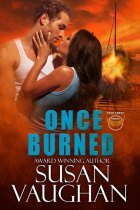 The Kindle version of ONCE BURNED, in my Task Force Eagle series, is on sale now through May 15 for only 99 cents. Here’s a short description: When Jake must protect Lani from a killer, his undercover case becomes tangled with the old fire that killed his girlfriend, Lani’s twin.
The Kindle version of ONCE BURNED, in my Task Force Eagle series, is on sale now through May 15 for only 99 cents. Here’s a short description: When Jake must protect Lani from a killer, his undercover case becomes tangled with the old fire that killed his girlfriend, Lani’s twin.
ONCE BURNED is one of eight that take place in Maine. You can find it here: http://getBook.at/OnceBurned
This Is The End, My Only Friend, The End

Have you ever arrived at the end of your novel and realized it just didn’t work? Or that you had no idea how to end it? Or who did the crime and why they did it? If the answer to these questions is yes then don’t feel like you’re alone. All of us writers feel this way at one point or another.
riting a compelling ending is hard work. It requires a lot of thought and contemplation. You have to be adaptable and willing to look at your story from different angles. How many times have we read a great novel, often one by a big name author, and been sorely disappointed by the ending? It’s almost as if they got tired of their story and just stopped. As writers, we definitely don’t want to leave our hard-earned readers on a sour note.
If writing endings were easy, everyone would be a writer. At times, I wish being a writer was like being a starting major league pitcher. You pitch the first eight innings of the game and then have a closer come in to finish the ninth for you. But alas, if you want to be an author, writing a satisfying ending is something we must learn to do.
Using another sports analogy; the best defense is often a good offense. And by this I mean that half the battle in composing a great ending is writing a great story. Making the reader care how your story ends means you’ve done a successful job holding their interest. Now you need to smoothly land this jet plane that is your plot and make sure your passengers get to their gates. You’ll need to provide an ending that will give closure and allow the reader to walk away satisfied.
The type of book you’re writing can often determine the type of ending you’re shooting for. A police procedural or cozy mystery requires that the ending be neatly wrapped up. Domestic thrillers, which I write, often have ambiguous endings, leaving the reader wondering what just happened. A great example of this is Gillian Flynn’s GONE GIRL. After all the horrendous things Nick’s wife has put him through during the course of the novel, Nick realizes at the end that he can’t just up and leave her. Amy’s gotten herself pregnant, and Nick is terrified that his child will be raised by this evil woman.
Many readers were angry that Flynn ended her novel this way. Others loved this ambiguous ending. It left the reader contemplating about will happen next in their relationship. It’s the same reaction many viewers had when watching the last episode of The Sopranos. Tony and his family are sitting in the booth of a diner. Mysterious people walk in and out. There’s something tense and scary about this scene. We wonder what’s going to happen. Will Tony and his family get killed? Then the screen goes black and that’s the end of the show. Some people loved this ending while others despised it and felt they’d been cheated for all the time and effort they put in watching the series.
The show, Breaking Bad, on the other hand, has a well defined plot arc that resembles a rainbow; at the end is a pot of gold. The writers wrapped up the show and left no question about Walt’s fate. Each show ended differently, for entirely different reasons, and each ended in interesting fashion. The ending fit the story line.
Not to get metaphysical, but what actually is an ending? If you ask yourself this question, I believe it will make writing your endings that much easier. Or at least less harder. Because, when one thinks about it, an ending is merely the beginning of something else. Consider what will happen to your surviving characters after your book ends. If it’s a series, the conclusion will impact how your characters act and think in the next book.
The most important aspect of your ending is this: how will the main characters change or be changed by the events that happened in your plot. Sometimes a violent, action-packed ending is not what’s needed. Sometimes, it’s how your character has changed that leaves the reader emotionally impacted. As in GONE GIRL, Nick is left reeling because he will have to live with his evil wife for the foreseeable future. This type of profound ending hits like a sledgehammer and keeps the reader thinking about your story long after it’s finished.
Lay the groundwork for your ending by writing a killer plot. A strong storyline will do much of the heavy lifting when it comes to crafting the conclusion. Spend time thinking about how to close out your novel even while you’re writing it. Sometimes it helps to write out a few different scenarios before you find the one that fits best. Often, it will take a few rewrites to get it just right. Then, if you’re like me, you’ll listen to your agent and editor, both of whom will give you additional input as to bring your storyline together.
Don’t get discouraged. Endings are tough. Persevere and work your way through them. And with that, I wish you the best writing that killer ending.
May 10, 2022
Win a Book Wednesday, May 11, 2022
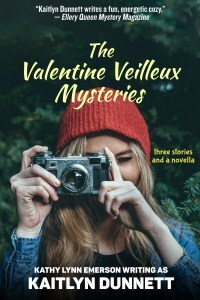
Congrats to Molly Weston, whose name was drawn to win a copy of Kathy Lynn Emerson/Kaitlyn Dunnett’s The Valentine Veilleux Mysteries. Thanks to all who left comments to enter. Your thoughts on what happened to my series characters after their series came to an end were much appreciated.

Kathy Lynn Emerson/Kaitlyn Dunnett has had sixty-four books traditionally published and has self published others, including several children’s books. She won the Agatha Award and was an Anthony and Macavity finalist for best mystery nonfiction of 2008 for How to Write Killer Historical Mysteries and was an Agatha Award finalist in 2015 in the best mystery short story category. She was the Malice Domestic Guest of Honor in 2014. Her most recent publications are The Valentine Veilleux Mysteries (a collection of three short stories and a novella, written as Kaitlyn) and I Kill People for a Living: A Collection of Essays by a Writer of Cozy Mysteries (written as Kathy). She maintains websites at www.KaitlynDunnett.com and www.KathyLynnEmerson.com. A third, at A Who’s Who of Tudor Women, is the gateway to over 2300 mini-biographies of sixteenth-century Englishwomen.
CHARACTER HISTORY: I WONDER OVER A MARTINI AT A PUB
 King Eider’s Pub, Damariscotta: a dozen Dodge Cove oysters in front of us. Hundreds of large-scale, numbered-on-the-bottom beer mugs hang from the rafters (the manager tells us it’s a couple hundred dollars for a one-time buy of the mug, the buyer gets a special hook on the ceiling and discounted beer for life). The sun’s coming in the picture window, our booth has a nice warm feel to it. We started the day moving, cleaning up dirt, grime, and mice droppings and then, I began painting and continued for eight hours, so I welcome my martini with gusto.
King Eider’s Pub, Damariscotta: a dozen Dodge Cove oysters in front of us. Hundreds of large-scale, numbered-on-the-bottom beer mugs hang from the rafters (the manager tells us it’s a couple hundred dollars for a one-time buy of the mug, the buyer gets a special hook on the ceiling and discounted beer for life). The sun’s coming in the picture window, our booth has a nice warm feel to it. We started the day moving, cleaning up dirt, grime, and mice droppings and then, I began painting and continued for eight hours, so I welcome my martini with gusto.
Clear, most of the day was painting – funky fiber-board walls in a recently-purchased, sixty-year-old, well-loved but amateur-built, lopsided camp fifteen miles from the Pub. I decided to paint everything white – to cover up the tired, streaked, banana yellow color that, over decades, had experienced coffee sprays, detritus from a leaky roof, dog scratches and what I think must have been a few nacho fests or salsa food fights? Or was it a crazy crayon battle? Magic Marker mayhem? Catsup catastrophe?
There are these random streaks along the baseboard in the mini-sunroom. They’re reddish. They cluster in and around a corner where the wiring for an old cable hook-up still lives.

The inexpensive one-coat primer/paint I bought from the cute and efficient hardware sales guy was supposed to do the trick. He’d told me he’d been in the Navy and tasked with painting and repainting ships’ interiors for his entire years of service, so, of course he was knowledgeable about paint. He recommended this hardware-store-brand paint; said he’d painted his whole house with it, had no problems at all.
But maybe he’d never encountered this STUBBORN RED. A red that refuses to be subdued.
I painted. Let the wall dry. Painted it again. Let the wall dry. The STUBBORN RED streaks and splatters were momentarily covered and – seconds later – they rose to the surface again like corpses – the ones that float to the top of a river if they haven’t been properly weighted down.
Is it blood? I know our brains are all going there.
I don’t know.
Wikipedia tells me I can get blood off walls using Clean Magic Erasers or Scotch-Brite Eraser pads.
 It also tells me that an artist in New York named Vincent Castiglia uses his own blood as paint because he wants to connect on an “intimate level” with his work and his patrons. And since, he says, human blood contains iron oxide (a pigment found in many traditional paints) he figured “what a perfect substance to create that intimacy”. Castiglia’s work is not cheap, and it does sell, so I guess his “body-fluid presence” graces a lot of people’s homes.
It also tells me that an artist in New York named Vincent Castiglia uses his own blood as paint because he wants to connect on an “intimate level” with his work and his patrons. And since, he says, human blood contains iron oxide (a pigment found in many traditional paints) he figured “what a perfect substance to create that intimacy”. Castiglia’s work is not cheap, and it does sell, so I guess his “body-fluid presence” graces a lot of people’s homes.
Quick research also tells me that I can paint over blood. Experts say it may take one coat – at the most two coats. It should be able to be forced to disappear into the walls.
But, after four coats of paint, my STUBBORN RED has not disappeared. It does a teasing disappearance act, then keeps appearing on the surface again with a “can’t get rid of me” smirk.
The painting dilemma led me to thinking about another problem I’m facing: How much backstory should go into a book series? When should it appear and when should it disappear? I’m into the third book of my Dee Rommel Mystery series, and this question is consuming me.
I’m not a disciplined “read-in-the-order-the-author-hoped-for” person. I prefer to do that, but sometimes it’s not convenient – or I make a mistake and pick up the wrong book.

How much backstory/history does the reader want or need? Louise Penny has given us 17 (so far) books featuring great main characters. Each book sets up (reminds us) of Chief Inspector of Surete du Quebec Armand Gamache and his intense love of his wife, his pride in his children, and his worry about his right-hand man’s (Jean-Guy) former drug addiction. Also, she provides the histories of the odd assortment of villagers and the reasons for their quirky attitudes. And sometimes (sometimes not) quick re-caps of past investigations. She does remind us of the current state of mind of the characters and the current political/personal climates of their work. As the series progresses, the characters go through changes and, for me, I appreciate Penny awakening my memories of what has gone on before.
I also appreciate how Penny manages to fill these memories swiftly. But how does she decide what to include in each of the books? She’s judicious, it’s not the same in each one. I would love to be schooled in how she decides what’s to be included.

Michael Connelly’s got 20 books (so far) featuring Bosch. Connelly doesn’t linger in backstory or in catching the reader up with Harry Bosch’s life. The books focus on the current crime. Harry’s personality (prickly, smart, a loner) is front and center, but, for the most part, not his past loves, friendships or living situations.
Patricia Cornwell (her Kay Scarpetta series) and Sue Grafton (in the Kinsey Malone series) do more. The exposition is woven in, sometimes overtly, sometimes elegantly.

I love Anne Perry’s various crime/mystery series (Charlotte and Thomas Pitt (30+ books), William Monk (20+ books), Daniel Pitt (6 books) and Elena Standish (4 books), but I do find myself wanting more backstory/history for each of her characters – it would make it easier for me to jump on board the story train. I don’t want to spend time, as a reader, googling past synopses or trying to remind myself of past plots and relationship timelines, I want to be subtly fed what I need to remember.

M.C. Beaton’s Agatha Raisin series keeps the reader informed of the “why” the character is in the state she’s in (relationships, career, state of mind) and then moves forward with the crime/mystery. Beaton gets the backstories “out of the way” early, and moves on.
Janet Evanovich, in most of her 27 books in the Stephanie Plum series, holds the reader’s hand a bit and provides a catch-up. The character, Plum, has aged and grown and changed. If I’ve missed a book in the “proper” sequence, she fills me in.
I haven’t read Joe Nesbo for a few years, and I could be wrong, but I think Harry Hole does not get a big backstory fill-in. Let me know if I am falsely remembering the stories.
Back to my STUBBORN RED. After the fifth coat of paint, and watching the red disappear and then rise again to the surface, I figure that – in a way – the RED is telling me there might be some interesting history or backstory to this funky cottage that I am now calling “mine”.

Now to the questions that concerns my dilemma: how much history and backstory is too much (or too little)? How do I make sure readers can jump on board the Dee Rommel series’ story train with going down the exposition rabbit hole?
Would love to know how other people handle it.
May 9, 2022
Something’s Gotta Give
 When I began to write “for real,” I was working. There was never enough time to do what needed to be done, even when I woke up at 4 AM to peck away. Watching television soon went by the wayside, and not only because I couldn’t wrestle the remote away from my husband. I got antsy and guilty sitting around, and most shows were simply not my cup of tea. No canned laughter for me. No darkness and gore and violence. And definitely no Real Housewives of Botoxia and Implantistan.
When I began to write “for real,” I was working. There was never enough time to do what needed to be done, even when I woke up at 4 AM to peck away. Watching television soon went by the wayside, and not only because I couldn’t wrestle the remote away from my husband. I got antsy and guilty sitting around, and most shows were simply not my cup of tea. No canned laughter for me. No darkness and gore and violence. And definitely no Real Housewives of Botoxia and Implantistan.
Fast-forward to present-day Maggie, who still doesn’t turn on the TV in the living room, but…
I confess. I am cheating on my book and streaming stuff on my computer. Here I sit barefoot at my desk, my screen bigger than the first black and white TV my parents bought in the fifties. I am a fool for procrastination—my current WIP has been about half-way done for too many months to count. I’ve tricked myself into thinking I’m doing “research” by watching newish mystery series. I dream of the Lady Adelaide books being optioned (Manifesting. Make it so. I will put shoes on for the premiere.).
I always had trouble committing to “tune in next week,” but how lovely it is to be able to binge several episodes at once, only pausing for snacks and nature. I prefer cozy, light, nearly disposable shows. However, I find gritty Slow Horses on Apple+ extremely compelling, though I’ve had to close my eyes for a lot of it. The writing is perfection. Gary Oldman is simply spectacular, but does need a shower.
If you, too, are looking to kill a few hours/search for inspiration, I have some suggestions. They are in no particular order, not even alphabetical. I may not watch much TV, but my husband has a subscription to virtually every streaming service out there, so some are on Acorn and BritBox. You will notice most shows take place in the UK, because I am a hopeless Anglophile and I miss our trips abroad.
McDonald and Dodds, set in Bath, England, features an older neurodivergent sergeant and his very ambitious young female boss who has come to count on his off-kilter detection skills.Agatha Raisin, based on the M.C. Beaton books. Nice ensemble cast. A bit (okay, a lot) silly in spots. Great clothes, though.The Chelsea Detective. London. A houseboat on the Thames. Multifaceted, empathetic leads. Really good and the city looks great.Only Murders in the Building. NYC. Sweet Selena Gomez with geezers Martin Short and Steve Martin. So much fun, though it got kind of crazy/uneven as the season went on. Can’t wait for Round 2 anyhow.Shakespeare and Hathaway. P.I.s in Stratford. Wonderful scenery. A tribute to British actors resembling real people in all their avoirdupois and scruffiness. No Botox here.Harry Wild. Ireland. Retired (abrasive, wine-swilling, grammar-and-literature-addicted) college professor discovers she has a knack for solving murders, much to her Garda son’s dismay.Murder in Provence. Mature adults in a mature relationship. Food. France. More food. No subtitles necessary because they’re all British actors who look like they’re having a blast drinking French wine in lavender fields after work.Madame Blanc. France again with British actors. Armchair travel avec antiques.Whitstable Pearl. Kent, UK. Diverse cast. A little moody. Interesting cases. The beach. Made me want to drink beer, eat seafood, and watch the sun go down.Why Didn’t They Ask Evans? Wales. Classic Christie. I’d read and seen it before, but this latest production was very stylish and I’m going to watch it again.I also viewed the new Dalgliesh iteration. I read all the books when they came out decades ago, so consequently remember none of the plots, LOL. The look is very evocative of the time period, which is slightly depressing. Dalgliesh’s male sergeant is as sleazy as they come, and has the mustache to prove it. It’s very well done, but I can’t say it warmed my heart.
What have I missed? What else should I be watching? Will I ever finish my book? Stay tuned.
May 6, 2022
Weekend Update: May 7-8, 2022
 Next week at Maine Crime Writers there will be a posts by Maggie Robinson (Monday) Jule Selbo (Tuesday), Joe Souza (Thursday) and Susan Vaughan (Friday).
Next week at Maine Crime Writers there will be a posts by Maggie Robinson (Monday) Jule Selbo (Tuesday), Joe Souza (Thursday) and Susan Vaughan (Friday).
In the news department, here’s what’s happening with some of us who blog regularly at Maine Crime Writers:
GIVEAWAY!

Kaitlyn Dunnett/Kathy Lynn Emerson is giving away a print copy of The Valentine Veilleux Mysteries (three short stories and a novella featuring a calendar and pet photographer as the amateur sleuth). To enter, leave a comment after reading Kaitlyn/Kathy’s last blog https://mainecrimewriters.com/2022/05/02/whatever-happened-to-and-a-giveaway/#comments The comment should be left AT THAT POST. A winner will be drawn on May 10.
An invitation to readers of this blog: Do you have news relating to Maine, Crime, or Writing? We’d love to hear from you. Just comment below to share.
And a reminder: If your library, school, or organization is looking for a speaker, we are often available to talk about the writing process, research, where we get our ideas, and other mysteries of the business. We also do programs on Zoom. Contact Kate Flora
May 5, 2022
Rooting for Routine
Things have been a bit chaotic in my life this past month.
In 2021 we learned the folly of waiting until spring to line up people to do things around the house that we can’t do ourselves. Covid-related materials shortages and overbooked contractors meant we waited until late summer for a new patio door and early fall for a replacement fence.
This year, we began active planning in January. Our list included some pandemic-delayed indoor projects, including painting the downstairs and installing new flooring in the living room. April would be a good time to get the work done, we figured, and it would be most efficient to schedule jobs back-to-back. This turned out to be true, but boy, was it ever discombobulating.
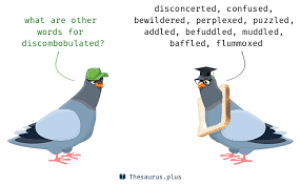
Every time the painting action moved from one room to the next, we had to shift furniture, strip the windows of their curtains and do other preparatory work that left our house looking like we were either moving out or moving in.
But the painting was a picnic compared to the flooring, which required us to relocate all of the living room furniture into the den for several days. This made for a lot of seating, but to watch TV you had to vault over the back of the couch, which was jammed up against the loveseat. Once ensconced, you were pretty much stuck for the evening.
I worked from home for a few days while this was going on, juggling phone calls and trying to draft documents with a power saw and a hammer for background accompaniment. Not easy for a woman who likes to work in near silence. Not easy at all.
By the beginning of this week I was starved for normalcy. All I wanted was to go to work at my office and come home to a house that looked like our house, eat a typical dinner at the normal time and do a bit of writing before winding down in front of the TV.
I didn’t want to move furniture around. I didn’t want to rehang artwork. And I most assuredly didn’t want to try to watch the Red Sox game from my favorite chair, which was marooned in the kitchen with a bad sightline for the clicker.
My spouse observed that I always have a hard time when my routine is disrupted.  I was so crabby I almost debated the point until I realized the truth in her words. I think of myself as both easygoing and resilient, but the fact is, when my world gets turned upside down—even temporarily—I’m like a child who hasn’t had her nap.
I was so crabby I almost debated the point until I realized the truth in her words. I think of myself as both easygoing and resilient, but the fact is, when my world gets turned upside down—even temporarily—I’m like a child who hasn’t had her nap.
I take comfort in predictability. I get up at the same time each morning, drive a favored route to work, eat the same thing for breakfast and lunch each weekday, return home more or less at the same hour in the evening and settle in after dinner to write.
Boring? Maybe, but it works for me, which is why disruption of my nest threw me for such a loop.
But the other truth I had to face Monday evening when I was feeling out of sorts is that amid all of this tumult, I haven’t been able to maintain my writing routine in the past month.
I like to write every day. I don’t always achieve it, but I’m happiest when I’m in that rhythm. For the past month I’ve not had the time or energy to maintain it, and that’s why this is probably the grumbliest post I’ve ever put up on MCW.
Rest assured that next month I’ll be back in my usual groove, observing all my daily rituals, banging out some words every day, and writing a more cheerful post. Unless another major something needs to be done around here, in which case all bets are off.
READERS: Are you creatures of habit or happiest when life is unpredictable? Please feel free to share your experience in the comments.
Brenda Buchanan brings years of experience as a journalist and a lawyer to her crime fiction. She has published three books featuring Joe Gale, a newspaper reporter who covers the crime and courts beat. She is now hard at work on new projects. FMI, go to http://brendabuchananwrites.com
DOES SILENCE IMPLY CONSENT?
John Clark sharing a very personal experience. By now you have seen the stories regarding the leaked documents from the supreme court regarding Roe VS Wade and the sense that the justices are leaning heavily toward abolishing that landmark decision. Make no mistake, this affects men as well as women.
In the early 1970s, I was in a contentious and dysfunctional relationship with a young woman who was attending a Maine college. It was one of those that should never have come about, but weren’t many of us stubborn and afflicted with poor judgment in our early twenties?
She was on the pill, so the thought of pregnancy wasn’t something I worried about. I should have. She decided the pill was making her fat and stopped taking them, but didn’t tell me. The next thing I knew, two people who were completely unprepared to become parents, were facing that reality. Legal abortion was only available in New York at that time. We agreed that despite the distance, cost, and possible traumatic effects, that was our choice.
I remember answering an ad in The Maine Times and scheduling the appointment. To say the drive down was tension-filled would be an understatement. I wasn’t allowed to wait at the clinic, so I wandered around NYC and have a vague memory of eating lunch at a Chinese restaurant. After returning to the clinic and paying while she was being discharged, we drove back to Maine with very few words being spoken.
The relationship ended shortly thereafter. However, the emotional part of the experience and the associated memories remain to this day. Would I want to go through it again? No, and I’m grateful I never had to make such a choice again, but I do not want that choice stolen from others in similar, or more dire situations. That seems to be on the horizon.
My point in sharing this experience is this: Ask yourself whether you want others to have a choice? Are the people running for office that you’ll be voting for respect the right of women to choose what happens to their bodies, or are they so full of self-righteousness they’re incapable of respecting others’ needs for personal freedom? If this right is abolished, what one will be targeted next?
Lea Wait's Blog
- Lea Wait's profile
- 509 followers



